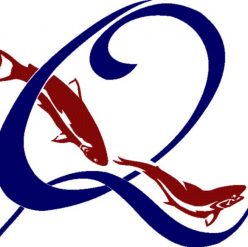NVISEA operates under a federal DFO contract with Salmonid Enhancement Programs and the Community Economic Development Program (CEDP). This provides core operational funding for NVISEA’s hatchery activities and salmon production. NVISEA enhances eleven stocks in five North Island drainages. Four species of salmon are enhanced, Pink, Chum, Coho and Chinook.
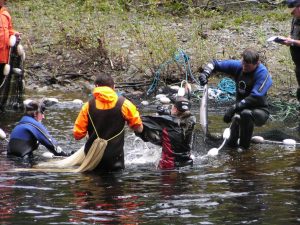
NVISEA is also provincially funded for Steelhead Trout enhancement by Freshwater Fisheries Society of B.C. Two winter run stocks, Quatse and Cluxewe, are sometimes enhanced depending on provincial regulations.
All Steelhead fry and smolts and all Coho smolts produced by NVISEA are adipose clipped for identification of hatchery raised fish.
Current Production Targets as 2021
Quatse River
- 1.5 million Pink fry (unfed)
- 110,000 Coho smolts (20 grams)
- 120,000 Chum fry (1.0 grams)
Cluxewe River
- 950,000 Pink fry (Unfed)
- 110,000 Coho smolts (20 grams
Marble River
- 1.2 million Chinook smolts (3 to 7 grams) (100,000 reared to 20 grams in sea pen)
- 50,000 Coho smolts (25 grams)
- 150,000 Coho fry (1-2 grams)
Fish Culture
Brood Capture
Quatse River Hatchery enhances five species of Pacific salmon in four North Island drainages. In September and October the Quatse staff use a seine net in low river conditions to capture adult salmon. These brood fish are transported by truck to the hatchery and held until ripe. Fish production at the Quatse Hatchery was rated as one of the most efficient CEDP facilities on the BC coast.
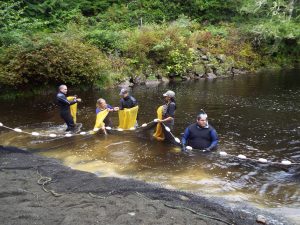
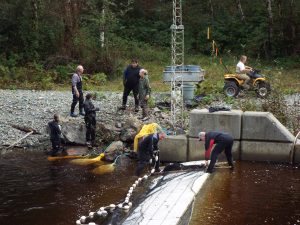
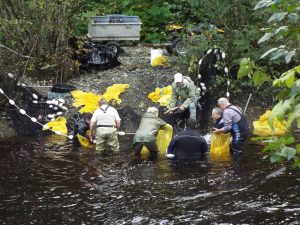
Brood stock capture takes place in the fall.
Each stock is genetically unique and must be held separately from one another. Spawn timing varies by stock and species, with Pinks and Chum spawning first from late September to mid October. Coho are the last to spawn from late October to early December. The Quatse River Hatchery has also enhanced winter Steelhead from our two North Island rivers, the Quatse River and the Cluxewe River. These Steelhead spawn in the spring, from February to April and they can survive to spawn over multiple years.
Anglers would help in the program of catching wild brood for this project and has proven to be very popular.
Spawning and Incubation
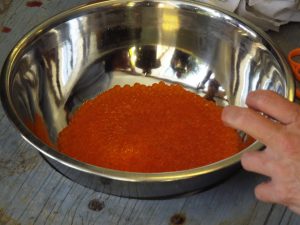
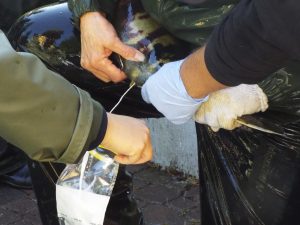
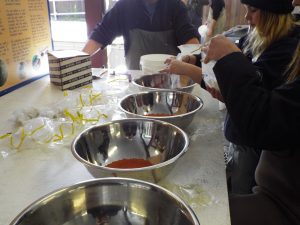
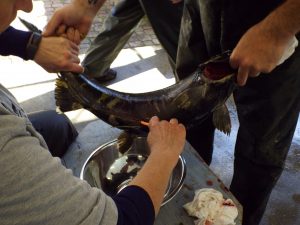
Captured females are checked weekly to determine maturity. The spawned carcasses are returned to the river of origin to provide in-stream nutrients.
Fertilized eggs are placed into incubation containers, with incubation typically lasting for six months.
Juvenile Rearing
Fry rearing strategies vary with species. Pink are released immediately. Efforts are made to release these fry at dusk to avoid predation. Our Quatse Chum are held at the hatchery and are fed for about three weeks in order to attain the weight of 1 gram to increase survival. Then released into their stream where their parents were captured.
For Coho, Chinook and Steelhead, fry are ponded into rearing containers where they are initiated on feed. Hatchery Chinook are reared for three months targeting five grams smolt release in June.
Coho are ponded in February and March, Our Coho and Steelhead fry are transported to the O’Connor Lake Net Pen facility in early September. The Coho smolt target size is 25 grams, while the Steelhead smolt target size is 80 grams. Both are released in May to their streams of origin.
All of NVISEA’s smolt and Steelhead production is adipose clipped for hatchery origin identification. This allows angler retention of the hatchery produced fish, and it also allows identification of the hatchery contribution to the return.
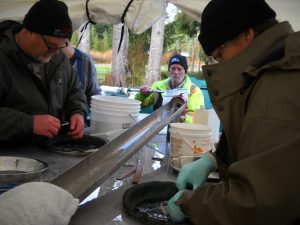
Transport and Release
NVISEA utilizes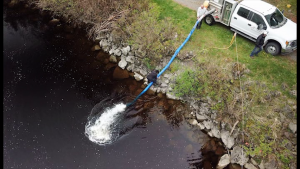 s three one ton flat deck trucks. All three trucks are equipped with holding tanks of water that are aerated during transport. These trucks are used extensively for brood capture and fry releases.
s three one ton flat deck trucks. All three trucks are equipped with holding tanks of water that are aerated during transport. These trucks are used extensively for brood capture and fry releases.
All fish are returned to their river of origin by truck at different times by natural migration.
Stock Assessment
Swim Enumeration
NVISEA has certified technicians trained to perform in swift water, they are also trained in species identification and river safety. NVISEA provides their technicians with the necessary equipment to safely conduct their brood captures and other ongoing duties.
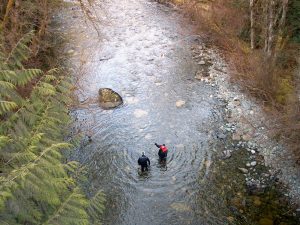
Electronic Counters
NVISEA has partnered with DFO and Kwakiutl First Nation to use an advanced in stream counting device known as DIDSON (Dual Frequency Identification Sonar). This technology makes it possible to assess a unique May run of Quatse River Sockeye salmon which would otherwise be difficult due to the tannin colour of the Quatse River water.
The Quatse River fish counter is comprised of electronic sensors and cameras to count fish heading up stream to rivers and lakes. A fish trap is also available when needed to assess species and gender.
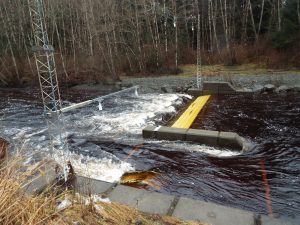
Juvenile Enumeration
NVISEA is active in a number of juvenile enumeration projects when required.
NVISEA partners with the Friends of the Marble River Society for the operation of the Marble River Rotary screw trap and the Sara Lake outlet monitoring fence.
Environmental Monitoring
NVISEA has technical expertise and equipment to perform a wide variety of environmental monitoring projects. Past projects have involved monitoring bridge re-decking, road de-activation, culvert removal, and replacement. They also contribute to habitat construction when needed.
